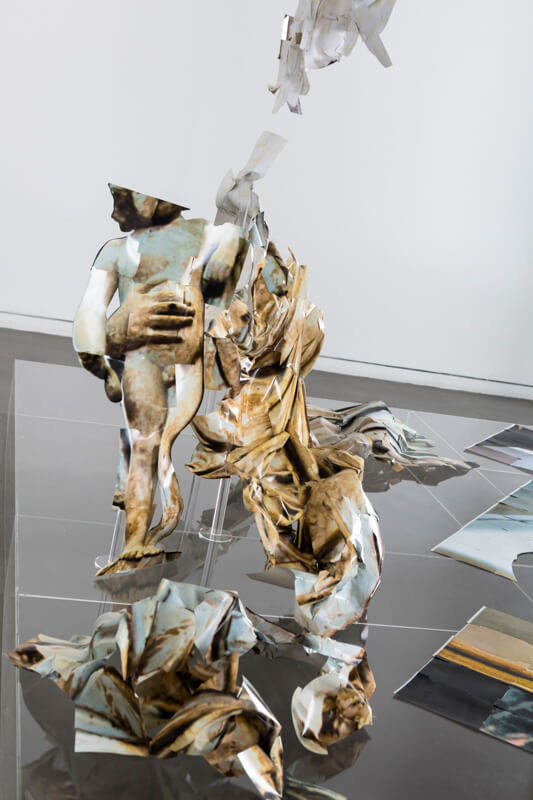Curator: Shlomit Breuer
Irit Tamari’s works examine the scopes of photography from sculptural, pictorial, photographic and architectural perspectives. Medium-related curiosity, which converges into border blurring between painting, statue, and photography, motivates her to probe the photographic image, understand it materially, and deconstruct and reconstruct it through another field. The practice characterizing her thought and work processes always begins with deconstruction and ends with splicing. Tamari cuts the photograph manually in order to deconstruct it and relieve it from the matter as well as from the image; this act of dissection is inspired by her wish to liberate the photograph from its own papery nature and reflectively point to the gap between the photographed object’s depth and the flatness of the photographic paper. In an image that was fixated by the act of photography, the object strives – in the words of Walter Benjamin – “to live inside rather than outside the moment.”[1] It is the act of cutting and splicing that instills movement in an image that the camera has frozen.
Tamari’s “About Florence” series originated from photographs of renaissance marble statue taken by her at the corridor of the Academia Gallery Museum in Florence. Subsequently, she proceeded to cut the photographs, which somewhat resembled generic tourist postcards, and reassembled the clippings in the form of a new object. By dismembering the photographs and reworking the two-dimensional paper into a new three-dimensional object, Tamari seems to add photography to the age-old theoretical debate about the dialectical, visual and substantial relationship between the various art disciplines. In this context, suffice it to remember that according to Michelangelo, “there is as much difference between painting and statue as between shadow and truth.”[2]
[1] Walter Benjamin, “A Short History of Photography,” Screen (1972) 13, no. 1, p. 17.
[2] Cited in Robert J. Clements, Michelangelo: A Self-Portrait, Englewood Cliffs, N.J.: Prentice-Hall, 1963, p. 9.
Confronting a Statue
8/12/17-17/2/18
Confronting a Statue
Tamari’s tarrying in the Renaissance period allows her to rid herself not only of the burden of history, but also of that of the matter and the image, and to challenge any boundaries of mass or frame. As far as she is concerned, the paper is transformed into marble in need of re-sculpting by taking away not only the superfluous, but also its ideational representations of culture, beauty and harmony. However, it is the current Zeitgeist imbued as it is with ideas of the interchangeability and osmosis of materials and media, along with preservation considerations that make it necessary to move increasingly growing number of statues into roofed spaces and exchange them with replicas, that dictates, for her, the modelling of her ephemeral paper statues. Emphasizing their fictionality, Tamari takes the liberty to re-imagine and re-sculpt the photographic original.
In the second series featuring in the exhibition, “Homage to Shosh Cormosh,” Tamari treated pages from Shosh Cormosh: Terms of Stillness – Works, 1987-2001 and examined issues of materiality, originality and imitation, transformation and time.
Side by side with Tamari’s exhibition, a selection of photographs and collages from Shosh Cormosh’s (1948-2001) “Terms” and “Order and Cleanliness: A –” series are on display in Basis’s project room. Cormosh, an artist with distinctive language, whose work defies strict medium definitions, concealed the presence of any remnant of signs of life wishing, as she said, to create “cyclical and continuous time, a sort of time-beyond-time, an absolute present that stands still.”[1]
[1] See “Tali Tamir in Conversation with Shosh Kormosh,” in A. Yariv and N. Haikin (eds.), Shosh Kormosh: Terms of Stillness – Works, 1987-2001, Tel Hai and Tel Aviv: The Open Museum of Photography and Gordon Gallery, 2008, p. 246.
In the second series featuring in the exhibition, “Homage to Shosh Cormosh,” Tamari treated pages from Shosh Cormosh: Terms of Stillness – Works, 1987-2001 and examined issues of materiality, originality and imitation, transformation and time.
Side by side with Tamari’s exhibition, a selection of photographs and collages from Shosh Cormosh’s (1948-2001) “Terms” and “Order and Cleanliness: A –” series are on display in Basis’s project room. Cormosh, an artist with distinctive language, whose work defies strict medium definitions, concealed the presence of any remnant of signs of life wishing, as she said, to create “cyclical and continuous time, a sort of time-beyond-time, an absolute present that stands still.”[1]
[1] See “Tali Tamir in Conversation with Shosh Kormosh,” in A. Yariv and N. Haikin (eds.), Shosh Kormosh: Terms of Stillness – Works, 1987-2001, Tel Hai and Tel Aviv: The Open Museum of Photography and Gordon Gallery, 2008, p. 246.
read more

